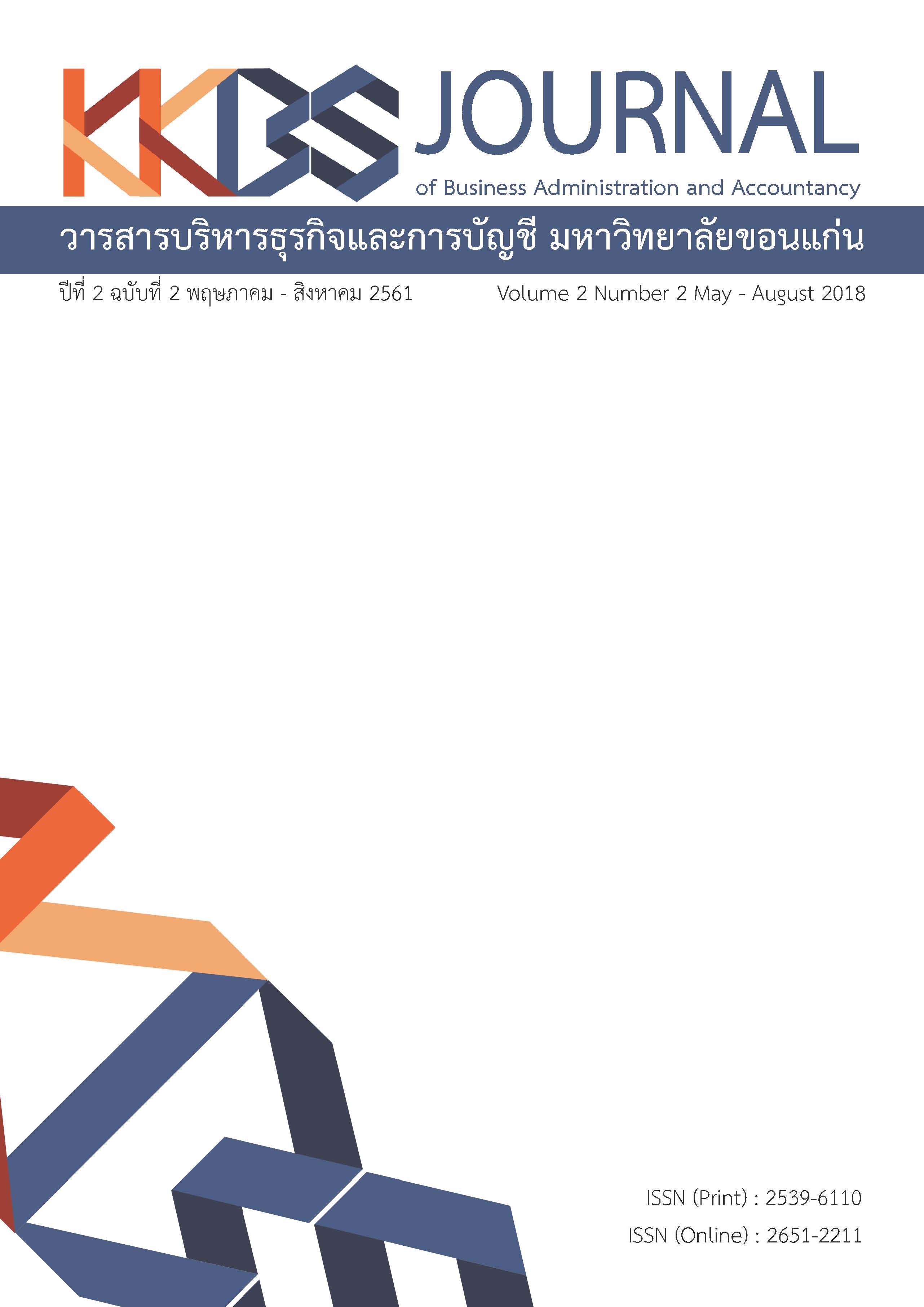พฤติกรรมการท่องเที่ยวของผู้สูงอายุ: กรณีศึกษาในเขตเทศบาลนครขอนแก่น
Main Article Content
บทคัดย่อ
งานวิจัยนี้มีวัตถุประสงค์เพื่อศึกษาพฤติกรรมการท่องเที่ยวและปัจจัยที่มีอิทธิพลต่อค่าใช้จ่ายในการท่องเที่ยวของผู้สูงอายุในเขตเทศบาลนครขอนแก่น ซึ่งเป็นกลุ่มตัวอย่างหนึ่งของผู้สูงอายุในเขตเมือง ในภาคตะวันออกเฉียงเหนือ ผลการศึกษาพบว่ากลุ่มตัวอย่างผู้สูงอายุส่วนใหญ่มีค่าเฉลี่ยอายุ 65 ปี มีค่าเฉลี่ยรายได้เท่ากับ 20,968.30 บาทต่อเดือน และค่าใช้จ่ายในการเดินทางท่องเที่ยวของผู้สูงอายุในรอบ 1 ปีที่ผ่านมานั้น มีค่าเฉลี่ยเท่ากับ 10,208.10 บาท จำนวนครั้งในการเดินท่องเที่ยวมีค่าเฉลี่ยอยู่ที่ 2 ครั้ง ผู้สูงอายุส่วนใหญ่มักเดินทางท่องเที่ยวไปยังแหล่งท่องเที่ยวทางประวัติศาสตร์และเดินทางในช่วงฤดูหนาว ซึ่งมีความแตกต่างจากผลการศึกษาอื่นที่ผ่านมา สำหรับผลการศึกษาปัจจัยที่มีอิทธิพลต่อค่าใช้จ่ายในการเดินทางท่องเที่ยวของผู้สูงอายุโดยใช้การวิเคราะห์การถดถอยแบบพหุคูณ (Multiple regression analysis) ด้วยวิธีกำลังสองน้อยที่สุด (Ordinary Least Square) พบว่า จำนวนครั้งในการเดินทางท่องเที่ยว ระยะเวลาที่ใช้ในการท่องเที่ยวในแต่ละครั้ง และรูปแบบของการเดินทาง เป็นปัจจัยที่มีอิทธิพลต่อค่าใช้จ่ายในการเดินทางท่องเที่ยวของผู้สูงอายุในเขตเทศบาลนครขอนแก่นอย่างมีนัยสำคัญทางสถิติ ยกเว้นปัจจัยทางด้านเพศ อายุและรายได้ ซึ่งไม่สอดคล้องกับผลการศึกษาของ Jang and Ham (2009) และ Kuo and Lu (2013) ที่พบว่า อายุและรายได้มีอิทธิพลต่อค่าใช้จ่ายในการท่องเที่ยวของผู้สูงอายุและ Nimhiranwong (2001) ที่พบว่าเพศและรายได้มีความสัมพันธ์กับค่าใช้จ่ายในการเดินทางท่องเที่ยว ทั้งนี้ อันเนื่องมาจากความแตกต่างทางเศรษฐกิจและสังคมของกลุ่มตัวอย่างผู้สูงอายุที่ศึกษา ดังนั้น การกำหนดกลยุทธ์การท่องเที่ยวสำหรับผู้สูงอายุ ควรมุ่งเน้นการตลาดแบบเฉพาะกลุ่ม (Niche marketing) เพื่อให้สามารถตอบสนองความต้องการที่แท้จริงของผู้สูงอายุแต่ละกลุ่มได้ ซึ่งข้อมูลนี้จะเป็นประโยชน์ต่อผู้วางแผนนโยบายและผู้ประกอบการในอุตสาหกรรมท่องเที่ยวต่อไป
Article Details
บทความที่ได้รับการตีพิมพ์ในวารสารเป็นความคิดเห็นของผู้เขียน มิใช่ความคิดเห็นของกองบรรณาธิการและคณะผู้จัดทำวารสาร และบทความที่ได้รับการตีพิมพ์เป็นลิขสิทธิ์ของวารสารบริหารธุรกิจและการบัญชี มหาวิทยาลัยขอนแก่น
เอกสารอ้างอิง
Chiewpattanakul, A., Adisornprasert, W. and Yansomboon, S. (2011). Factors affecting saving behavior and spending behavior of senior citizen. Srinakharinwirot Research and Development (Journal of Humanities and Social Sciences), 3(6), 178-194. (InThai)
Cochran, W. G. (1977). Sampling techniques (3rd ed.). New York: John Wiley & Sons.
Damchoo, P. (2015). Information and communication technologies for sustainable tourism. Journal of Business, Economics and Communications, 10(2), 167-170. Retrieved from https://www.tci-thaijo.org/index.php/BECJournal/article/view/54007. (in Thai).
Dwyer, L., Forsyth, P., and Dwyer, W. (2010). Tourism Economics and Policy. UK: Channel View Publications.
Gladwell, N.J. and Bedini, L.A. (2004). In search of lost leisure: the impact of care giving on leisure travel. Tourism Management, 25, 685-693.
Jang, S.C. and Ham, S. (2009). A double-hurdle analysis of travel expenditure: Baby boomer seniors versus older seniors. Tourism Management, 30, 372-380.
Kuo, H.I. and Lu, C.L. (2013). Expenditure-based segmentation:application of quantile regression to analyse the travel expenditures of baby boomer households. Tourism Economics, 19(6), 1429-1441.
Lauterborn, B. (1990). New marketing litany; four Ps passe; C-words take over. Advertising Age. 61(41), pp.26.
Ministry of Tourism & Sports. (2017). Press Conference: Tourism Situation December 2017. Retrieved March 5, 2018, from https://www.mots.go.th/ more_news.php?cid=421& filename=index. (InThai)
National Statistical Office. (2016). The Elderly people, 1990 - 2083. Retrieved December 10, 2017, from http://social.nesdb.go.th/SocialStat/StatReport_Final.aspx?reportid=1209&template=2R1C&yeartype=M&subcatid=27. (In Thai)
National Statistical Office. (2017). The 2017 household survey on the use of Information and communication technology. Retrieved April 10, 2018, from http://www.nso.go.th/sites/2014en/Pages/Statistical%20Themes/ICT/The-2012-Information-And-Communication-Technology-Survey-In-Household.aspx. (In Thai)
Nimhiranwong, S. (2001). Factors related to the elderly’s preference for internal tourism. Master’s Thesis, Mahidol University. (In Thai)
Onarun, K. (2010). Factors affecting domestic tourist behavior of senior thai citizens. Independent Study, Department of Economics, Kasetsart University. (InThai)
Otakanon, B. (2012). 4C's Revolutionary Marketing. College of Management, Mahidol University. Retrived April 10, 2018, from http://thaifranchisedownload.com/dl/group13_6445_20140108150608.pdf. (In Thai)
Patterson, I., and Pegg, S. (2009). Marketing the leisure experience to baby boomers and older tourists. Hospitality Marketing and Management, 18(3), 254-272.
Rattanaphaitoolchai, A. (2015). Elderly market new thai opportunities rise AEC. Bangkokbiznews. 3(153), 1. (In Thai).
Sangkakorn, K. et al. (2015). Tourism Management and Administration in the Upper North of Thailand for Supporting Senior Tourists. Retrieved April 10, 2018, from http://www.sri.cmu.ac.th/~ctrd/uploads/files/file_20171206_1512542336.pdf. (In Thai)
Tourism Authority of Thailand launched tourism plan in 2017. (January 3, 2017). Matichon online. Retrived December 10, 2017, from https://www.matichon.co.th/news/414696. (InThai).
Thubseerak, C. (2012). Qualitative variable for multiple regression. MSU Journal. 17(1), 31-42. (In Thai).
World travel & Tourism council. (2017). Travel & Tourism Economic Impact 2017 Thailand. Retrieved March 5, 2018, from www.wttc.org
Yuwa, H.W. (2007). The Glittering Silver Market: The Rise of the Elderly Consumers in Asia, Singapore: John Wiley & Sons.


